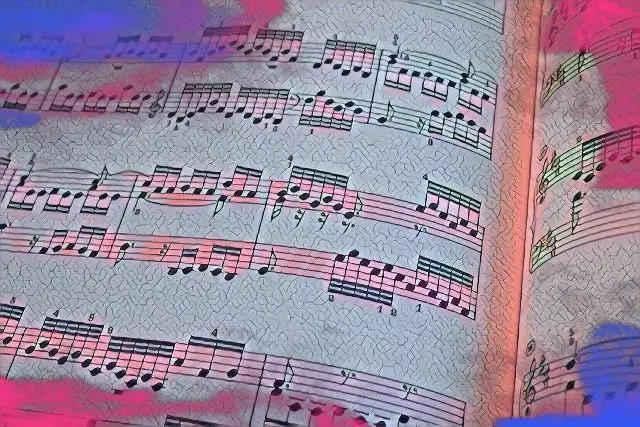The world of scales is vast and seemingly endless. From major scales to harmonic scales to chromatic scales, it can be overwhelming to think about how many scales one needs to know.
However, amidst this abundance, there exists a scale that stands out as exceptionally versatile and practical – and surprisingly, it is not the major scale.
Of course, while the major scale is undoubtedly fundamental and one of the most widely used, there is another scale that surpasses it in terms of usefulness. This scale offers a remarkable range of applications and is often considered the cornerstone of musical exploration.
By mastering this scale, you can unlock countless melodic possibilities and play millions of songs.
So, what is this scale that reigns supreme?
The scale in question is the pentatonic scale , and in this guide, we're going to discuss everything you need to know about it, from its origins to how you can use it in your music!
What Is the Pentatonic Scale?
Unlike the major scale, which consists of seven notes, the pentatonic scale is constructed using only five notes, hence its name. Its simplified structure grants it a unique advantage in various musical contexts.
The pentatonic scale's simplicity and versatility make it a staple in numerous genres, from rock and blues to jazz and traditional folk music. Its inherently consonant nature allows for effortless melodic improvisation and harmonization.
Plus, with a limited number of notes, it's far more accessible to beginners, while still offering endless creative possibilities to seasoned musicians.
There are two primary variations of the pentatonic scale - the major pentatonic scale and the minor pentatonic scale.
These scales share a close relationship with their major and minor counterparts, and we'll get into them in a little bit.
But first...
The Origins of the Pentatonic Scale
Although widely employed in contemporary music, the pentatonic scale has a long-standing history in the realm of music. Astonishingly, archaeological discoveries have revealed musical instruments tuned to the pentatonic dating back approximately 50,000 years.
This indicates that the pentatonic scale has been a fundamental aspect of musical expression for thousands of years.
Furthermore, the prevalence of the pentatonic scale across different epochs of music suggests its early development in Western music.
Early forms of music, such as Gregorian chants, incorporated pentatonic melodies, emphasizing its enduring presence. Additionally, the pentatonic scale manifests in various forms within traditional African, Native American, and South Asian Music, transcending cultural and geographical boundaries.
No matter what era you travel to or musical tradition you explore, encountering the pentatonic scale is virtually unavoidable, underscoring its universal appeal and widespread utilization.
The Major Pentatonic Scale
Let's begin by exploring the major pentatonic scale .
It bears a direct connection to the major scale as it consists of the very same notes, with only two exceptions.
To understand this relationship more clearly, major scales can be denoted using degrees or numbers that represent each note.
Let's take the example of G major for reference.
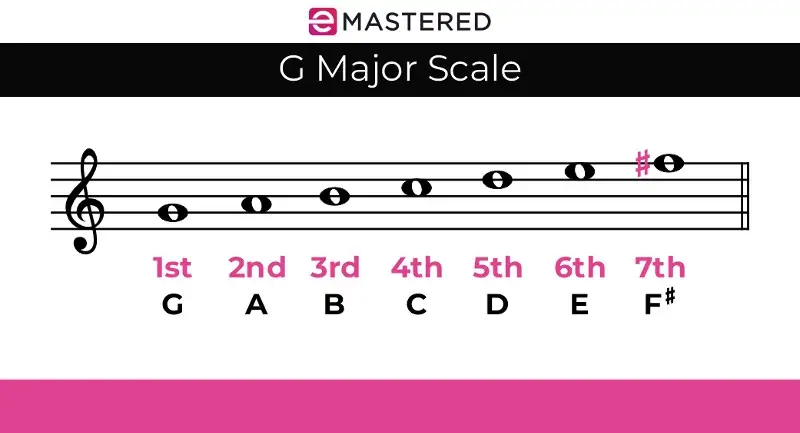
Assigning degrees or numbers to the notes of the G major scale allows us to illustrate which degrees are omitted to form the G major pentatonic scale.
In the case of the G major pentatonic scale, we omit degrees 4 and 7.
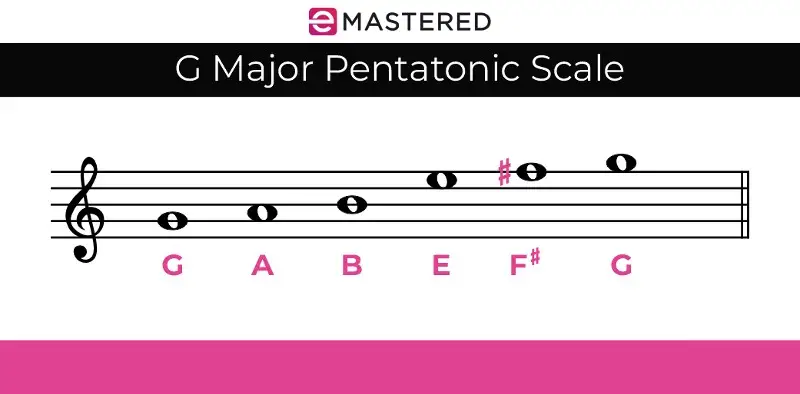
An alternative way to conceptualize the major pentatonic scale is by considering the intervals it comprises:
- Tonic (root note)
- Major second
- Major third
- Perfect fifth
- Major sixth
These intervals outline the distinctive character of the major pentatonic scale and provide a helpful perspective when studying and playing it.
The Minor Pentatonic Scale
The second essential pentatonic scale that's important to know is the minor pentatonic scale .
Similar to the major pentatonic scale, the minor pentatonic scale is formed by selecting five notes from the minor scale.
Let's start by exploring the creation of the E minor pentatonic scale.
The reason I picked E minor is because E minor is the relative minor of G major, meaning it's comprised of all the same notes, just arranged differently!
To begin, let's write down the E natural minor scale and assign degrees to its notes.
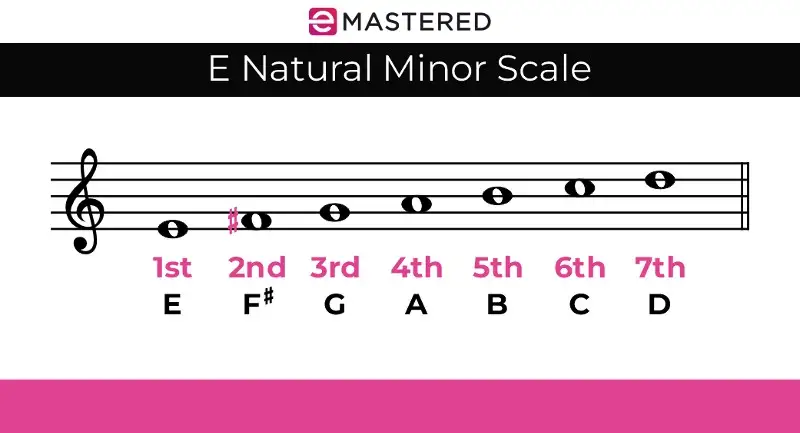
When constructing the E minor pentatonic scale from the natural minor, we exclude the 2nd and 6th degrees.
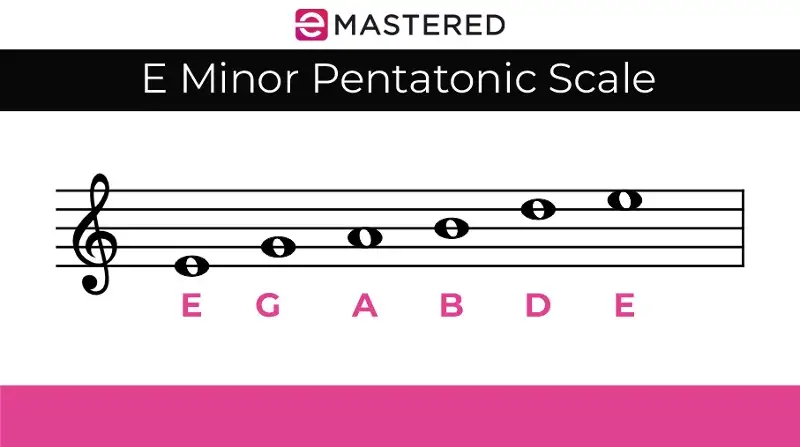
Another way to approach the minor pentatonic scale is by considering the intervals it encompasses:
- Tonic (root note)
- Minor third
- Perfect fourth
- Perfect fifth
- Minor seventh
Again, these intervals delineate the characteristic sound of the minor pentatonic scale and provide a useful framework for understanding and utilizing its distinct melodic qualities.
How to Play the Pentatonic Scale on Piano
Now that you have a better understanding of the pentatonic scale, let's look at a few examples of C pentatonic scales that can be played on the piano:
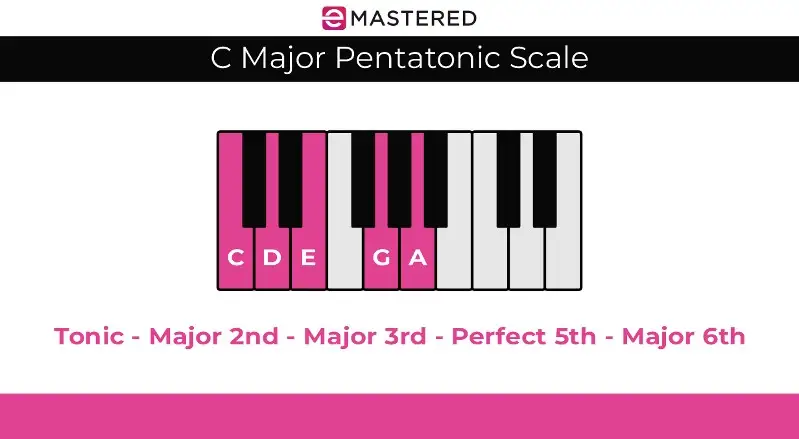
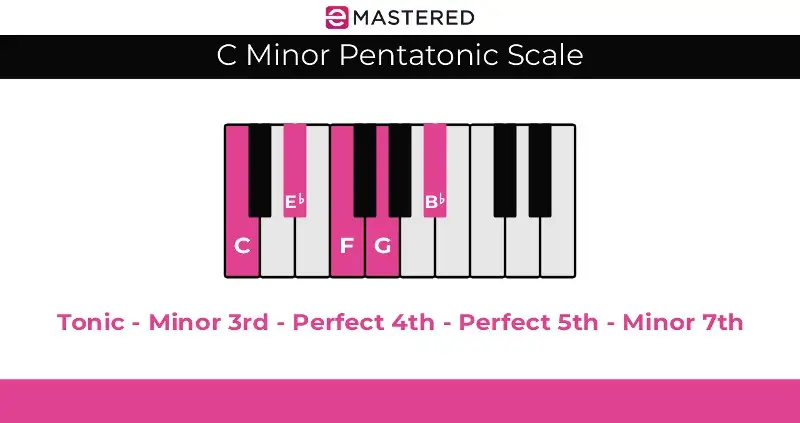
How to Play the Pentatonic Scale on Guitar
If you're a guitarist, here's how you can play the pentatonic scale on your axe!
Major Pentatonic Scale on Guitar
Whenever I'm thinking about the major pentatonic scale on my guitar, I think about the CAGED system.
You've likely heard of the CAGED system before, as it's a popular method used by guitarists to navigate and visualize chord shapes, scales, and arpeggios across the fretboard.
This system provides a framework that connects the five basic open chord shapes of C, A, G, E, and D, which are commonly referred to as the "CAGED" chords.
Beyond the chordal aid it provides, guitarists can employ the CAGED system of box shapes to play major and minor pentatonic scales.
For example, let's consider the 'E' shape. When starting from the first note on the E string and beginning at the 3rd fret, you would be playing the G Major Pentatonic scale. This serves as an illustrative example of how the CAGED system can be utilized to navigate and play different pentatonic scales on the guitar.
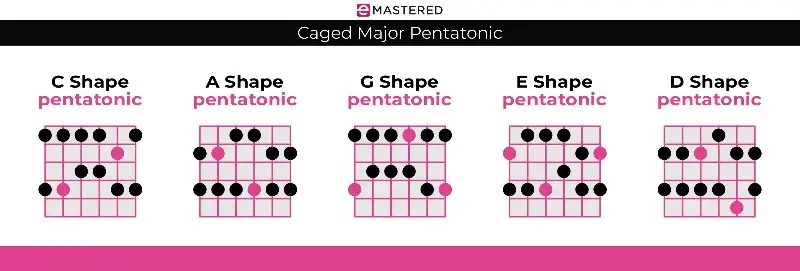
In the diagram above, you can see the various CAGED shapes you can employ to play the major pentatonic scale anywhere on the neck of the guitar.
Minor Pentatonic Scale on Guitar
Next, we have the minor pentatonic scale on guitar.
There exists a close relationship between major and minor scales.
As we now know, E minor serves as the relative minor of G major, indicating that they share the same key signature, including the presence of F#.
Consequently, the shapes used for the major pentatonic scale can also be applied to the minor pentatonic scale. However, the positioning of the root notes will differ.
For example, if we look at the 'E' shape for the minor pentatonic scale, it begins on the root note. If we were to start this shape at the 5th fret, we would be playing the A minor pentatonic scale.
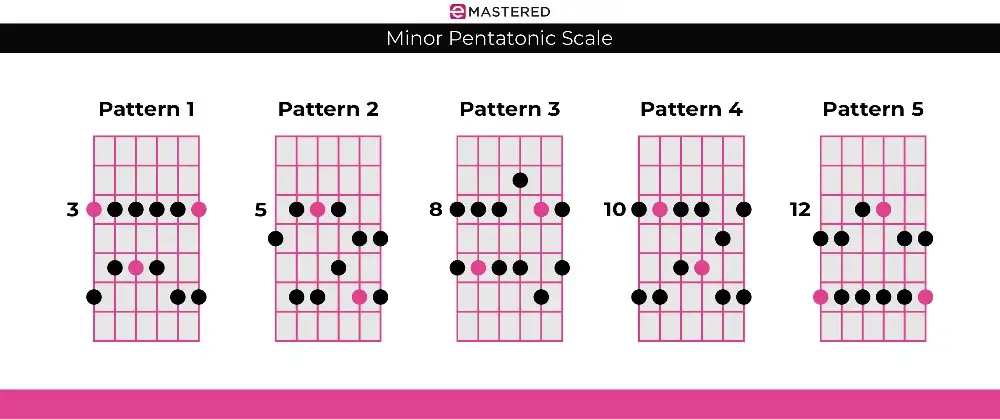
The main difference you hear will just depend on which note is functioning as the tonic.
Transposing the Pentatonic Scale
Transposing a scale involves shifting it to a different position while maintaining the intervals and preserving the scale's distinctive sound.
For instance, if you have learned a melody in the C major pentatonic scale, but your vocalist struggles with reaching the lower notes, you might need to transpose it to a higher key to accommodate their vocal range.
In doing so, you can ensure that the melody remains intact while making it more accessible for the singer.
While transposing might seem like a dark art, it's quite simple.
The key lies in understanding the intervals between each note within a scale, which allows you to shift the notes while retaining their proper placement based on these intervals.
The process is straightforward - you move each note of the scale by the same interval as the initial note.
So, for instance, if you are transposing from C major pentatonic to Eb major pentatonic, and you moved the C up by a minor third, you would apply the same interval to the remaining notes.
Consequently, the D note would be moved up to F, the E note to G, and so forth, maintaining the integrity of the scale's intervals throughout the transposition.
How to Use the Pentatonic Scale
Because the tonic note is what determines the quality of the scale, the major and minor pentatonic scales can be applied in the same musical contexts where the major and natural minor scales are used, respectively.
However, the versatility of the pentatonic scales extends beyond these familiar contexts, offering additional possibilities that are not as easily accessible with the natural major and minor scales.
For starters, you'll find a widespread popularity of the pentatonic scale in rock and blues music. The scale has remarkable compatibility with various musical elements, harmonizing exceptionally well with major scales, minor scales, dominant seventh chords, church modes, and more.
It's pretty customary to solo using the pentatonic scale over chord progressions in rock music, so if you're a beginner musician that wants to swiftly delve into improvising rock solos, it can be an incredibly valuable tool.
Notably, the minor pentatonic scale holds an indispensable role in blues improvisation, and it is often introduced to novice guitarists early on due to its versatility and relatively easy playability.
Let's look at a few reasons why we might utilize the pentatonic scale.
Improvisation
The pentatonic scale can be effectively utilized not only over major chord progressions but also minor and classic 12-bar blues progressions.
With its collection of consonant notes, it exhibits a pleasing sound when applied to a wide range of musical contexts.
If you want to experience its versatility firsthand, I encourage you to experiment by playing the pentatonic scale over a backing track like the one above.
Playability
Once you commit specific pentatonic scale patterns on your fretboard and keyboard to memory, you gain the ability to effortlessly transpose them into any key.
By doing so, you gain the power to navigate the pentatonic scale with flexibility.
Modal Playing
If you've ever explored music theory before, you've likely heard of modes.
Modes can feel like a bit of a complex topic for beginners, so I highly recommend checking out our article on music modes to get a better understanding.
For the purpose of our pentatonic scale discussion, church modes can be classified as either major or minor.
The major modes encompass Ionian, Lydian, and Mixolydian, all of which share the scale degrees 1, 2, 3, 5, and 6, while the minor modes are the Dorian, Phrygian, Aeolian, and Locrian.
Each of the major modes incorporates a major pentatonic scale within its structure, rendering the major pentatonic scale an ideal choice for composing, improvising, or playing over modal backing tracks.
Take Advantage of Its Uplifting Nature
Similar to the conventional major scale, the pentatonic major scale is renowned for its uplifting and positive quality.
Its construction focuses on pleasant-sounding intervals, primarily major intervals, which are commonly associated with positivity, triumph, happiness, etc.
In contrast to the more somber and narrower minor intervals, the pentatonic major scale deliberately avoids dissonant intervals, resulting in a cheerful and optimistic musical character.
Of course, it is worth noting that although minor 3rds exist within the pentatonic major scale, if utilized judiciously, they can contribute to a specific section of the scale to evoke a darker or sadder ambiance.
Overall, however, the pentatonic major scale exudes a predominantly joyful tonality.
Use the Major and Minor Chords Within It
While it is uncommon to exclusively utilize the pentatonic scale for constructing harmonic patterns, there may be instances where you desire to rely solely on this scale to create your harmony.
Of course, the inherent nature of the pentatonic scale, with its omission of certain intervals, can make the formation of traditional major chords a bit intricate. This means you have to have careful consideration and creative approaches to navigate the harmonization process AND adhere to the pentatonic scale's limitations.
In the major pentatonic scale, for example, you'll find only one complete major chord, which is the tonic.
So, in the key of C major, this corresponds to the C major chord (C-E-G), which can be a powerful choice for resolving chord progressions.
One interesting aspect of the pentatonic scale is that it contains a greater number of minor chords compared to major chords.
For example, in the key of C, you can form a partial Em chord with notes E and G, as well as a full Am chord with notes A, C, and E.
Utilizing these minor chords is a great way to add a level of harmonic depth and richness to any compositions that use the pentatonic major scale.
Use Its Dissonance
While adhering strictly to the major pentatonic scale for constructing harmonic sequences may not always yield the most favorable outcomes, it is important to recognize that the essence of pentatonic scales lies in their simplicity.
However, despite their simplified nature, these select groupings of notes can give rise to some pretty edgy dissonant chords.
I love embracing the unconventional in music, and occasionally straying from traditional harmonic expectations within the major pentatonic scale often results in unique and captivating chord progressions.
For example, you can play a combination of C, D, and E together to create a crunchy and dissonant chord, or bring E, G, and A together to get a funky Emsus4 chord.
If you're really feeling wild, you could even try playing all five notes of the pentatonic scale simultaneously!
Though these cluster chord might feel a bit strange at first, they possess a distinctive jazziness, thanks to the absence of semitones and tritones.
Approaching pentatonic harmony from this perspective is a great way to highlight its inherent value, rather than relying solely on unfinished and incomplete triads.
By exploring unconventional chord voicings and embracing the dissonance within the pentatonic scale, you'll uncover some petty incredible hidden musical possibilities.
How to Practice the Pentatonic Scale
Now, the question becomes, how do I get accustomed to the pentatonic scale?
I recommend following these practice steps to start:
Step 1: Memorize the Pentatonic Scales
The first thing you'll want to do is develop a solid understanding of the minor pentatonic scale and memorize it thoroughly.
Apply this scale within the tonal context, playing it in both major and minor keys by utilizing the pentatonic scale of the relative minor. You should dedicate a considerable amount of time to practicing and familiarizing yourself with this scale, as you'll be able to use it in seemingly infinite contexts.
Step 2: Apply the Minor Pentatonic Scale in a Blues Context
The minor pentatonic scale is the sound of the blues, and by applying it in this context, you'll become far more familiar with the genre.
Start by determining the key of the blues progression you are playing or improvising over to help you choose the appropriate minor pentatonic scale. You can then locate the root note of the key on your instrument, which will serve as the starting point for your pentatonic scale.
So, for example, if you are in the key of E minor, you'll want to start on the root note 'E' and use the E minor pentatonic scale.
What I highly recommend is experimenting with adding the "blue notes" throughout your improvisation.
The blue notes in the blues scales are the flatted 5th and flatted 3rd. These notes are great for adding a distinctively bluesy sound to your playing.
If you're playing guitar, you can explore different positions and patterns of the minor pentatonic scale on the fretboard, as it will help you cover a wider range of notes and create varied melodic ideas.
I highly recommend finding some common blues progressions to practice along with, such as the 12-bar blues. Once you get a better grip on playing the pentatonic scales in different positions, you can experiment with different rhythms, note choices, and improvisational ideas to develop your own blues style.
Step 3: Practice Ascending and Descending Pentatonic Scales
To step outside the box and come up with more interesting phrases and melodies, you'll want to be able to play the pentatonic scale in ascending and descending patterns.
As you practice moving up and down, experiment with different rhythmic patterns. Try playing in straight quarter notes, syncopated rhythms, or even triplets. Using different rhythms is a great way to solidify your rhythmic chops.
Step 4: Step Out of the Scale
When you watch the pros play, you don't often see them moving up and down the scale step by step. If you did, it'd get pretty mundane after a while. Instead, they find unique ways to break outside of scale degrees by skipping strings or keys.
For example, if you play stringed instruments, you can practice playing the pentatonic scale while skipping strings to improve your string navigation and fretboard dexterity.
Similarly, you can jump to different intervals within the pentatonic scale. For example, you could play the scale starting from the root note, then jump to the octave or other intervallic notes within the scale.
Going Beyond the Pentatonic Scale
While the pentatonic scale is indeed a simple and effective tool for crafting great music, relying solely on it for an entire song can lead to a lack of variety and potentially make you music monotonous.
Of course, many mainstream chart songs heavily lean on basic applications of the pentatonic scale, which can be effective in small doses.
However, due to the scale's widespread use, the intervals within it can feel overused.
The point that I'm trying to make here is don't rely exclusively on the pentatonic scales to get you by. Once you have it in your grasp, use it sparingly. Allow yourself the freedom to incorporate intervals from other major and minor scales.
Doing so will keep your music diverse and engaging for listeners, preventing it from becoming repetitive or predictable.
Throwing a semitone into the mix every now and then can have a revitalizing effect on your music. And no, stepping outside of the pentatonic scales won't make your music sound inaccessible or atonal. Instead, even something as simple as this subtle alteration can breathe fresh life into your tunes, making them FAR more interesting to listen to!
With all of that said, even by simply embracing the versatility of the pentatonic scales, you can tap into a range of musical possibilities and extend your library of knowledge as a musician.


